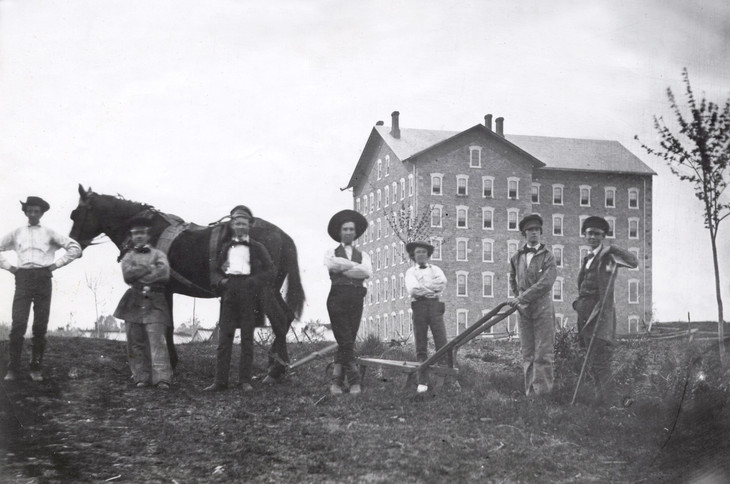Chartered by the Commonwealth in 1855, the Farmers’ High School of Pennsylvania by the early 1860s had become the first successful agricultural college in America.
The impetus for the school that became Penn State came from the Pennsylvania State Agricultural Society, founded in 1851 to promote the economic, political, and social interests of the state’s vast farming community. Frederick Watts, the society’s first president, wrote the organizational plan for the institution in a letter to Governor William Bigler in 1853.
The legislature chartered the school in April 1854, specifying sixty-five trustees, one from each county. It was impractical to gather that many trustees for meetings, so Watts and the society petitioned the state legislature for a new charter. The legislature did so, with Governor James Pollock signing it on February 22, 1855. The new charter specified only thirteen trustees — four ex officio and nine by name, including Watts and Hugh McAllister of Centre County.

The charter also required the trustees to encourage offers for the school’s site. Led by Governor Pollock, Watts and the trustees visited various places, the first being at Centre Furnace in Centre County on June 26, 1855, to inspect the offer of 200 acres from ironmaster James Irvin. After visiting his lands, “the Trustees and all the company repaired to the dwelling house of Moses Thompson of Centre Furnace where 150 people were entertained by a sumptuous dinner prepared by Mrs. Thompson.”
Irvin later sweetened his offer by including 200 acres of adjoining land to be rented and a guarantee — signed by Irvin, McAllister, and Andrew G. Curtin — to raise $10,000 from the citizens of Centre and Huntingdon counties. Considering additional offers at their meeting on September 12, 1855, the trustees — after much debate and several unsuccessful motions to accept other sites — finally approved Watts’s motion to accept Irvin’s offer. The site drew criticism because of its remote location, but Watts, now trustees president, defended it on “the essential advantages of soil, surface, exposure, healthfulness, and centrality.”
It took four years until the school could open for instruction on February 16, 1859. The first building was a barn designed by Watts and completed in 1856. Construction of the second building, known as the “College Building” (later Old Main), began in August 1856, with a state appropriation of $25,000. Construction continued until July 1858, when the contractor declared bankruptcy, a casualty of the Panic of 1857.
Meanwhile, the college farm, supervised by horticulturalist William G. Waring, was laid out and planted. The west wing of the College Building was completed in time to accommodate the school’s opening seven months later, when sixty-nine students showed up.
By that time, Evan Pugh had been hired as the school’s first president. Pugh, a native of Chester County, Pennsylvania, had spent six years in Europe studying scientific agriculture. He quickly built the institution into a successful agricultural college — no mean feat in the midst of the Civil War.
He revised the four-year curriculum, culminating in the Bachelor of Scientific Agriculture, the first degree of its kind offered in the United States, and graduated the first class of eleven students in 1861. He procured a grant of $49,900 from the legislature to complete the construction of the College Building.
Despite the drain of men and money for the war, Pugh built enrollments from eighty-eight in 1861 to 146 in 1864, making it the nation’s largest institution of its kind. In 1862, Pugh changed the name to the Agricultural College of Pennsylvania.
The greatest accomplishment of Pugh, Watts, and the trustees was their lobbying for the passage of the Morrill Land-Grant College Act, which President Abraham Lincoln signed into law in July 1862. The act awarded large tracts of federal land to states to be sold, with the proceeds used to establish an endowment for “at least one college where the leading object shall be . . . to teach such branches of learning as are related to agriculture and the mechanic arts [engineering].”
The state legislature accepted the act on April 1, 1863, designating the Agricultural College as the beneficiary. In early 1864, several colleges and their legislative allies tried unsuccessfully to apportion the proceeds to five other schools. Pugh died of typhoid fever on April 29, 1864, his death sending the college into a tailspin for the next eighteen years.
Roger Williams
Sources:
Bezilla, Michael. Penn State: An Illustrated History. University Park: Penn State University Press, 1985.
Dunaway, Wayland F. History of The Pennsylvania State College. Lancaster, Pa.: Lancaster Press, Inc., 1946.
Runkle, Erwin W. The Pennsylvania State College, 1853–1932: Interpretation and Record. Copyright 1933. Published by the Nittany Valley Society, 2013.
Williams, Roger L. Frederick Watts and the Founding of Penn State. University Park: Penn State University Press, 2021.
Williams, Roger L. Evan Pugh’s Penn State: America’s Model Agricultural College. University Park: Penn State University Press, 2018.
First Published: March 10, 2021
Last Modified: August 1, 2024
